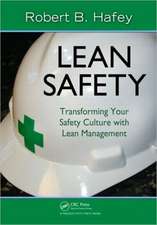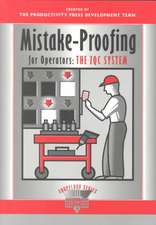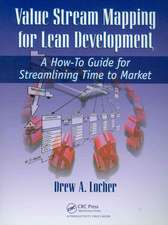Card-Based Control Systems for a Lean Work Design: The Fundamentals of Kanban, ConWIP, POLCA, and COBACABANA
Autor Matthias Thurer, Mark Stevenson, Charles Protzmanen Limba Engleză Paperback – 16 feb 2016
This book takes a different approach to most other books on the subject—as it starts with an introduction to the control problem, instead of the control solution. Card-Based Control Systems for a Lean Work Design outlines how the problems encountered in typical manufacturing shops and service providers can be characterized, which allows for improved problem diagnosis.
The first four chapters of the book lay the foundations for problem diagnosis. The next three chapters then discuss, in sequence, each of the three "traditional" card-based control systems: kanban, ConWIP, and Paired-cell Overlapping Loops of Cards with Authorization (POLCA). The book explains how each of these card-based control systems works and identifies the specific type of control problem to which each system applies.
The next two chapters focus on Control of Balance by Card-Based Navigation (COBACABANA), a system developed for high-variety shops producing made-to-order, customized products. This is the first book to discuss this novel approach, which includes the use of cards to estimate due dates or delivery time allowances.
The book closes with a framework that provides guidance on which system to apply. This framework contrasts the control problem with the control solution. The potential of combining card-based systems is also discussed to create a nested solution.
Preț: 240.24 lei
Preț vechi: 288.33 lei
-17% Nou
Puncte Express: 360
Preț estimativ în valută:
45.97€ • 48.12$ • 38.04£
45.97€ • 48.12$ • 38.04£
Carte tipărită la comandă
Livrare economică 07-21 aprilie
Preluare comenzi: 021 569.72.76
Specificații
ISBN-13: 9781498746946
ISBN-10: 1498746942
Pagini: 219
Ilustrații: 83
Dimensiuni: 178 x 254 x 13 mm
Greutate: 0.41 kg
Ediția:1
Editura: Taylor & Francis
Colecția Productivity Press
Locul publicării:Oxford, United Kingdom
ISBN-10: 1498746942
Pagini: 219
Ilustrații: 83
Dimensiuni: 178 x 254 x 13 mm
Greutate: 0.41 kg
Ediția:1
Editura: Taylor & Francis
Colecția Productivity Press
Locul publicării:Oxford, United Kingdom
Public țintă
Professional Practice & DevelopmentRecenzii
I know that the depth of theoretical and practical experience among the authors by Matthias Thurer, Mark Stevenson, Charles Protzman over a broad range of industries gives them extraordinary insight into the practical implementation side of "getting Lean" - The sum of this extensive learning is reflected in this new book; Card-Based Control Systems for a Lean Work Design: The Fundamentals of Kanban, ConWIP, POLCA, and COBACABANA. The reader will find that theauthors share critical information to develop and implement a successful shop floor control system for their organization. Anyone reading this book, whether they are just getting started or have many Lean implementations under their belt, will discover a wealth of thought provoking new material.
Victor Chance, Former VP Supply Chain Procurement & External Operations, Johnson and Johnson Medical Devices and Diagnostics Sector
Notă biografică
Matthias Thurer is a professor at Jinan University, China. He earned his master's degree from the Technical University of Berlin and a PhD from the University of Coimbra. He maintains a broad research network regularly visiting universities such as Lancaster University, the University of Clemson, Michigan State University and the University of Groningen. Before getting involved in academia, Matthias worked for several companies and became a master craftsman. Simple control for complex shops is one of Matthias' main research interests. He has published widely on production control systems and is a leading expert on Workload Control and Control of Balance by Card Based Navigation (COBACABANA). Mark Stevenson is a full Professor at Lancaster University Management School in the UK. He earned a bachelor's and PhD from the Department of Management Science at Lancaster University. Mark's PhD was on Workload Control, the production planning and control concept for low-volume, high-variety shops that underpins COBACABANA. Mark's research has included implementing the Workload Control concept in practice to learn from the implementation process and results. He has published widely in peer-reviewed academic Operations Management journals, including those on production planning and control. Charles Protzman is an internationally renowned Lean implementer, trainer, and Shingo Prize winning author with over 33 years of experience in Materials and Operations Management. He has consulted with manufacturers, hospitals, government agencies and other service industries. In 1997, Charlie formed Business Improvement Group, LLC, which is located in Baltimore, MD, and specializes in implementing Lean thinking principles and the Lean Business Delivery System - LBDS. Charlie has spent the last 22 years implementing successful Lean product line conversions, kaizen events, and administrative business system improvements (transactional lean) across the U.S. and internationally.
Cuprins
Basic ConceptsHighlightsWhat Is a Production/Service System?What Is a Business Operation/Process?What Does a Card-Based Control System Actually Control?Why Use a Card-Based Control System Rather than the Latest Technology?Summary: What Card-Based Control Systems Do (And What They Do Not Do) 20Highlights Revisited Basic Principles Underpinning a Card-Based Control SystemHighlightsInput/Output ControlVisualizing the Stability of the Shop Floor/Station: The Throughput DiagramSummary: Input/Output Control Underpinning Card-Based ControlHighlights Revisited Simplified Scheduling through Pool Sequencing and a Shop Floor Dispatching RuleHighlightsSome Rules for Priority Dispatching on the Shop FloorVisualizing On-Time Performance: The Order Progress DiagramSummary: Simplified Scheduling through Priority DispatchingHighlights Revisited How to Diagnose a Control Problem?HighlightsCriterion 1: Make/Produce/Assemble/Build/Serve, etc. To-Stock or To-Order Criterion 2: The Customer Penetration (Inventory/Order Separation) PointCriterion 3: Routing CharacteristicsCriterion 4: Variability and Uncertainty in Resource RequirementsSummary: Diagnosing the Control ProblemHighlights Revisited The Inventory Control Problem: Kanban SystemsHighlightsKanban for the Internal Supply Chain: The Six Rules of Kanban SystemsWork-in-Process Kanban vs. Production KanbanKanban for Shop Floor ControlApplicability of Kanban SystemsSummary: Kanban SystemsHighlights Revisited The Low Variability Order Control Problem: ConWIPHighlightsConWIP: How Does It Work?The Applicability of ConWIPSummary: ConWIPHighlights Revisited Inventory Control Plus Material Requirements Planning for the Order Control Problem: POLCAHighlightsPaired-Cell Overlapping Loops of Cards with Authorization (POLCA): How Does It Work?Applicability of POLCASummary: POLCAHighlights Revisited How to Solve the High Variety Order Control Problem: COBACABANAHighlightsControl of Balance by Card-Based Navigation (COBACABANA)COBACABANA: How Does It Work?Balancing Workloads: The Main Order Release Function of COBACABANACOBACABANA Recognizes the Difference between Direct and Indirect WorkSimplifying the Need for Processing Time EstimationsCOBACABANA and High Processing Time Variability: Starvation AvoidancePremature Station Idleness and Order ReleaseSummary: COBACABANAHighlights Revisited COBACABANA's Card-Based System for Delivery Time Estimation HighlightsCard-Based Delivery Time Estimation: How Does It Work?COBACABANA as a Comprehensive SystemUsing the Salesperson's Display for Output ControlSummary: COBACABANA's Delivery Date Estimation ProcedureHighlights Revisited Summary: Framework of ApplicabilityHighlightsLoop Structure and Its Implications for the Application of Card-Based SystemsCard Properties and Their Implications for the Application of Card-Based SystemsThe Need for IT Support and Its Implications for the Application of Card-Based SystemsFinal Considerations: Nested Card-Based Control SystemsImplementation Information
Descriere
This book takes a different approach than others on card-based control systems—as it starts with an introduction to the control problem, instead of the control solution. It outlines how the problems encountered in typical manufacturing shops and service providers can be characterized, which allows for improved problem diagnosis. In addition to the "traditional" card-based control systems, this is the first book that discusses control of balance by card-based navigation (COBACABANA), a system developed for high-variety shops producing made-to-order, customized products.







![Using Hoshin Kanri to Improve the Value Stream [With CDROM]: From Theory to Practice](https://i3.books-express.ro/bt/9781420084238/using-hoshin-kanri-to-improve-the-value-stream-with-cdrom.jpg)







